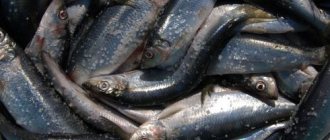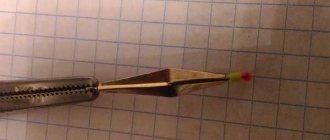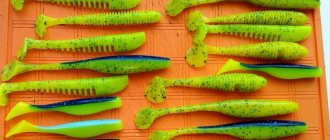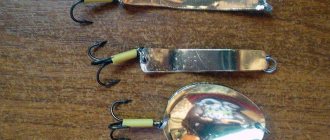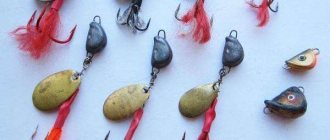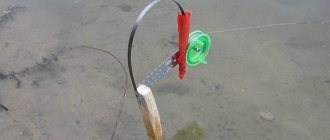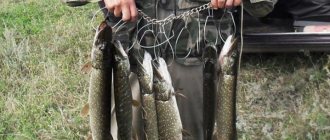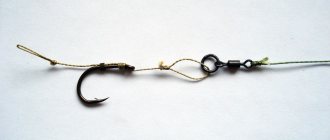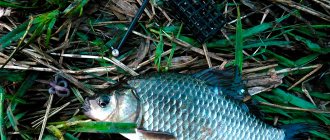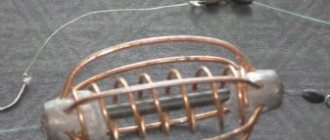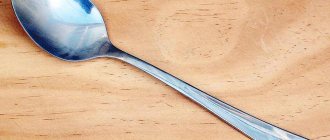In the world of sport fishing, this is one of the most famous types of spinners. Its inventor is Vladimir Matveychikov, whose name it bears. Although its form looks very simple, its stable performance will not disappoint you. Designed for winter perch fishing at a depth of one and a half to five meters.
Let's dwell on what kind of wiring should be here. The main method is a combination of a sharp rise and a free release. There are small-frequency oscillations here, which are combined with a smooth falling game. This game is effective not only with a good bite, but also in the dead of winter. To increase efficiency, you can vary the height of the swing or toss, you can get different styles of play from glider to nail.
It is designed for fishing in weak or no currents. Its enormous popularity is due to both its high catchability and the ease with which it can be made yourself. This spoon was originally created for sport fishing.
It is not recommended to use fasteners or carabiners with it. In this case, she will lose the opportunity to play quality games.
What type of spinner
This lure was invented by Vladimir Matveychikov, a famous Russian fisherman. Matveychikov's spinner is a bait for catching predatory fish from the ice. Its main purpose is to catch perch, although if desired, you can also catch other predators that live in our reservoirs.
According to the type of game, Matveychikov's spinner belongs to the falling spinners . Due to its unique play, Matveychikov’s spinner has excellent catchability. Classic Matveychikov spinners are used for fishing in still water at depths from 1.5 to 5 meters.
Appearance
There are two types of Matveychikov spinners - with a single soldered
and a hanging treble hook.
The latter are used for catching passive perch.
The classic Matveychikov spinner has a length of 40 mm, a width of 10 mm, an extension at the back and a characteristic bend, which ensures an original game. But since domestic fishermen are inclined to experiment, they make their own baits ranging in size from 25 to 100 mm while maintaining the original proportions, which can be used for fishing at different depths.
One side of the Matveychikov spinner is made of non-ferrous metal or alloy: copper, brass, cupronickel, beryllium bronze, the second is made of solder, although bimetallic spinners are also found.
Expert opinion
Knipovich Nikolai Mikhailovich
Zoologist, hydrobiologist. I am interested in fishing at a professional level.
Attention! The tee should be equipped with a bright epoxy resin drop. It is the “attack point” for the predator.
Advantages and disadvantages
The bait has the following advantages:
- high catchability;
- ease of making with your own hands;
- low cost of store-bought spinners;
- high fishing speed with a bait with a soldered hook, since the fish can be quickly unhooked;
- possibility of using different types of wiring.
At the same time, it is not without some disadvantages, the main of which are:
- the need to use a fishing line of a certain diameter to give the bait the necessary game;
- the need to fish without a fastener, since the use of the latter negatively affects the performance of the spinner;
- impossibility of fishing in strong currents.
Store options
Those fishermen who are not inclined to be creative on their own can purchase Matveychikov’s lure in fishing stores, especially since this bait is very inexpensive. The most famous manufacturers of this bait are the following:
- GOA Company. There is a wide range of spinners, including lures with single and treble hooks and different materials used in the production of the spinner.
- Samovar and Co. Classic spinners are produced with a length of 40 mm and a weight of 2.5 grams, equipped with a Mustad tee. The crown can be made of copper, cupronickel, copper, brass. Upon request, an angler can purchase a silver-plated spinner.
- R.B. The Optima brand produces spinners weighing from 2 to 6 grams, equipped with tees.
The cost of store-bought spinners does not exceed 300 rubles. The fisherman must decide for himself what type of fishing is his priority and choose the right lure. Beginner fishermen can be advised to use heavier baits with a hanging tee, since the fishing technique with them is simpler, and a moving tee will provide better results.
Purchase
The manufacturer GOA offers a classic version of this spinner for 300 rubles. There are several options on sale to choose from.
- Options for the material from which it is made. Cupronickel-brass.
- Cupronickel-copper.
- Nickel.
- Brass.
- Copper.
- Single soldered hook.
DIY making
To make a Matveychikov spinner you will need the following:
Drawing
The drawing must be prepared in advance. It is more convenient to do it on graph paper. Typically, various fishing sites offer drawings of a classic spoon 40 mm long and 10 mm wide. If you need to make a bait of a larger or smaller size, then all proportions must be observed.
Materials
- sheet metal 0.5 mm thick. It can be purchased in specialized stores, markets or ordered in online stores;
- solder, which is purchased in the same way;
- phosphoric acid for soldering;
- paste GOI;
- triple or single hook;
- winding ring;
- a pin or thin steel wire for making rings to which a fishing line is tied or a tee is attached.
Tools
- metal scissors;
- soldering iron;
- file;
- needle files;
- sandpaper;
- wire cutters;
- round nose pliers.
Step by step process
- They make a drawing.
- A piece 40 mm long and 10 mm wide is cut out.
- A longitudinal straight line is drawn on the workpiece with a sharp object.
- Measure 13 mm from one edge and draw a transverse line.
- All excess is cut off.
- The workpiece is bent in the longitudinal direction at an angle of 90 degrees.
- File all the corners, making them more rounded.
- Bend the workpiece, giving it a crescent shape.
- If a single hook is used, then the eye is cut off and the fore-end is soldered from the inside to the wide side of the workpiece. If a tee is used, a loop is soldered, which is made from a pin or wire.
- In a similar way, solder the ring to the narrow part of the workpiece.
- Apply solder to the inside of the workpiece;
- The workpiece is processed with a file and polished.
- Attach a tee, if provided.
Self-production
It’s quite possible to do it yourself. Here we will look at making a spinner weighing three grams. First, let's look at its drawing.
As we can see, the form is quite simple and does not seem to raise any questions
We list the materials that we will need in the manufacturing process:
- Copper sheet half a millimeter thick. Its dimensions should be sufficient to cut a part two centimeters wide and four meters long.
- The hook we are using here is Owner no.
- A piece of thin steel wire two centimeters long or the eye of a pin. This is necessary to make a loop to which the fishing line will be tied.
- Solder POS-40 and soldering acid. We will attach both the hook and the fastening loop to the tackle using a soldering iron.
- Sandpaper. You will also need GOI polishing paste. The fully manufactured product must be processed in this manner.
Step by step guides
Now we will describe in detail each step of making the Matveychikov spinner:
First you need to prepare a copper sheet for work.
To do this, draw a straight line along its middle with a sharp object. Now you will need to measure 13 millimeters from the edge of the line and draw a perpendicular segment.
We will make notches at a distance of 5 millimeters from the center line. It will look like this.
Now let's bend the sheet at a right angle along the original straight line. Let's step back 1 millimeter from the center line and draw a straight line through the previously marked notch.
Let's make the other three cuts in the same way. We get the following.
Now we need to process our workpiece using a file and a needle file. At this stage, it is necessary to carefully round off the sharp corners. Approximately at a distance of a third of the length from the side of the short part of the product, you need to slightly bend it towards the fold.
Now you need to treat the surface of its inner part. The result of our work must be thoroughly cleaned with sandpaper.
Next we will work on the crochet. First you need to use wire cutters to bite off the loop. The hook shank must be cleaned with sandpaper. After that it needs to be tinned. Having done this, let’s put it aside for now.
Now let's start attaching the loop to the spoon. Here one of two main options is usually used. To do this, you can use the eye of a pin or take a small piece of wire from a steel cable. In our case, we will use the second option. Let's twist the eyelet out of the wire core. It looks like this.
The fastening will need to be tinned using solder. Solder a loop on the inside of the long and narrow part. Now take the previously prepared hook and solder it on the inside of the short part of the spinner. Let's add some more solder here. We'll get something like this.
Everything is almost ready. You just need to sand the edges and the entire surface of the product with sandpaper. After this treatment, all that remains is to apply the GOI polishing paste.
This is what a fully manufactured Matveychikov spinner will look like.
Fishing tactics and playing technique
The tactics for fishing with Matveychikov’s lure are the same as when fishing with other winter lures and balancers. The main task is to find a perch or other predator. Since this bait was originally a sports spinner, and athletes, as a rule, have to catch small perch in lakes, a search is underway for places with the maximum concentration of this predator.
In the arsenal of an athlete, there are usually several pre-set fishing rods with fishing line of different thicknesses, designed for fishing at different depths and with baits of different sizes. It is better to look for fish with a spoon equipped with a treble hook. Once you get to a hole where the perch bites more or less consistently, you should switch to fishing with a spoon with a single bait, which will significantly speed up the fishing process. You can fish even faster with a lure with a barbless hook, simply throwing the caught fish off the hook with a movement of your hand.
It is important not only to find the perch, but also to keep it under the hole , and, if possible, raise it as high as possible from the bottom. An essential point in achieving the desired result, namely victory in competitions, is the search for places with larger fish.
For an amateur, it is important not only the quantity, but also the quality of the fish caught. Therefore, you should look for perch schools in which the average fish size is higher. The tactics for searching for perch in an unfamiliar body of water is to gradually move from the shore into the depths. If there are people gathering on the ice for hobby reasons, you should carefully monitor their movements and, if something happens, join the “crowd”, while adhering to the rules of fishing ethics.
Expert opinion
Knipovich Nikolai Mikhailovich
Zoologist, hydrobiologist. I am interested in fishing at a professional level.
Important! When fishing in many bodies of water, especially large ones, perch can stay not only near the bottom, but also in half-water. Therefore, you should fish different water horizons under the ice.
Matveychikov’s lure fishing technique looks like this:
- The bait is lowered to the bottom and hit it several times, creating a noise effect and a cloud of turbidity that attracts a predator.
- Make a sharp (sometimes smooth) rise with the tip of the fishing rod 30-50 cm from the bottom and, after a short pause, reset to the starting position.
- Be sure to pause at the lowest point, the duration of which depends on various factors, primarily on the activity of the predator.
- Repeat the cycle several times.
- They fish the horizon higher than the previous one.
- If there are no bites, they move to another place.
- If any activity of a predator is observed (tosses, pokes), but it is not possible to catch it, they try to change the game, and if this does not help, they change the bait.
Making a spoon
If you have all the tools, let's start making the spoon. It is best to have a ready-made paper template with a life-size sketch of the spoon printed on it. I print the templates on special paper that has an adhesive backing. It’s convenient because you remove the protective layer and you can immediately glue the template onto the workpiece.
Download the template for the maropedka spinner:
- 35 mm long can be found here (link to template No. 1)
- 40 mm long can be found here (link to template No. 2)
We cut out a small plate from a sheet of copper or brass and glue a paper template onto it.
Then, using metal scissors, we carefully cut out the blank of the future spinner from the plate. This should be done with a small margin around the circumference; it is better to modify it later with a file than to accidentally cut out the working part of the workpiece. The excess can always be removed, but the missing part cannot be glued back.
We process the cut-out workpiece, giving it the desired shape of a paper template.
I don’t peel off the template, there is a center line on it, and I don’t need to draw it directly on the metal, it’s more convenient for me. We insert the workpiece into the vice so as to bend it along the longitudinal center line at an angle of 90 degrees.
Using a small hammer, bend the upper part of the workpiece. By the way, the bend angle does not have to be exactly 90 degrees. According to some unverified data, the same Technologist makes “maroped” spinners with different bend angles, from 90 to 120 degrees. I can’t say whether this is true or not, but no one forbids experimenting. We will not deviate from the parameters and bend it at 90 degrees.
If necessary, we once again go through the edges of the workpiece with a file, remove burrs and irregularities and tear off the paper template; it is no longer needed.
We clamp the workpiece again in a vice and alternately process both outer sides with a file. If the thickness of the metal is 0.4 mm or more, you can partially grind it off, thereby obtaining an even and sharp bending angle.
Now let's put the workpiece aside
And let's start making ears for tying the fishing line and tee. The material for the eyes can be the forend of a hook of suitable size, a thin guitar string, I use ordinary pins for this, using wire cutters to adjust the length in accordance with the size of the crown of the spoon. If necessary, I bend the eye of the pin with pliers so that there is no gap.
Everything is ready, let's move on to soldering. We treat the inside of the crown with soldering acid, and after tinning both ears with solder, we solder them one by one into the body of the spinner.
Then fill the crown with solder. Here it is necessary to observe the temperature regime and try not to overheat the crown, otherwise the solder will flow out of it along with the soldered ears, and you will have to start all over again.
We solder it with solder so that it completely fills the inside of the crown of the spinner and protrudes slightly with a hump upward, about 2 mm, then remove the excess solder with a file.
When everything is ready, we equip the spoon with a tee. If you like the tee to have colored decorations, then you need to do this before we put the winding ring on the tee. I buy ready-made tees with a drop, but you can make your own.
We cut cambrics from colored nipple elastic and equip the tee with them.
We attach the tee through a winding ring with a diameter of 4-5 mm to the spoon. All is ready.
I don’t polish the spinner; I consider excessive “store-bought” shine to be unnecessary and sometimes harmful. Therefore, sometimes I specially make such spinners, with camouflage colors, for this I use brass from old car radiators.
It should be understood that in artisanal manufacturing conditions it is difficult to achieve absolutely the same size and shape of the spoon. By the way, about the sizes, I already mentioned that I could not find a drawing with the dimensions of the “maropedka” on the Internet. Perhaps I didn't search well. So I made this drawing myself.
The distance from the eye where the tee is attached to the widest part of the spoon can be in the range from ¼ to ½ of its length. The closer to the middle of the spoon its widest part is, the better the spoon plans. I choose the golden mean - 1/3 of the length. The spinner game is simple and uncomplicated.
We lower it to a depth of one or two centimeters from the bottom and lift it with a sharp swing of the rod; when the spoon glides and goes down again, we pause for a few seconds. Then we repeat everything. This is the main way to play. The bite most often occurs during a pause. You can probably play it differently
Everything written above is the personal opinion of the author. Thank you for your attention.
Taran Sergey Nikolaevich - Specially for the site Homemade products for fishing, Novokuznetsk, Russia
Alternatives to Matveychikov's spinner
Matveychikov's spinner is not the only bait used by sports fishermen and amateurs. Many amateurs use spinners with a soldered double, but using them in competitions is prohibited. The most well-known baits that can successfully replace the Matveychikov spinner are the following:
- Maropedka. A sports spoon invented by St. Petersburg athlete Alexander Vorobyov, a multiple champion of Russia and world champion in fishing. In fact, it is a hybrid of a Matveychikov spinner, a diamond and a torpedo. Gradually, amateur fishermen mastered it, increasing its size;
- St. Petersburg sleeper. A bait that allows for variability in size, equipment with hooks and the use of one or two crowns;
- torpedo A sports spinner with a length of 45 mm and a weight of 2.5 grams. The greater the depth, the thinner the fishing line is required to provide the bait with the desired play. It is recommended to fish by making short, smooth jerks;
- Mercedes. An original bait invented by Anatoly Kovalev.
Expert opinion
Knipovich Nikolai Mikhailovich
Zoologist, hydrobiologist. I am interested in fishing at a professional level.
Interesting! Its catchability is ensured by the fact that it has a chaotic game. It is quite difficult to master fishing with such bait, but if you can achieve this, success is guaranteed.
In amateur fishing, an alternative to a spinner can be the well-known triangulars, diamonds, petals, etc.
How to make a Matveychikov spinner with your own hands
Making bait does not require any special expenses. Some craftsmen can make bait in just an hour. You can use any material. The main thing is to have the necessary tool at hand.
Any production requires the preparation of materials. After all, if everything is at hand, then making the part will be much easier. Spinners can be made from different materials, many of which are available to every man.
To make a homemade element for fishing you need to prepare: pliers, metal scissors, hammer, file, vice, round nose pliers, soldering iron, needle file, electric drill, grinder, mallet, punch, matrix, emery.
Important! Homemade bait must be tested in water. Therefore, it is also necessary to prepare a transparent container
Please remember that working with power tools requires eye protection.
Drawings and dimensions
Initially, you need to make an image of the future part. For beginners, it is better to use ready-made drawings. Based on them, you can later make your own. The drawing is applied to thick paper (preferably cardboard), and then transferred to a metal blank. If there is no diagram, you can transfer the shape of a tablespoon to the workpiece.
The size of the lure depends on what parameters are planned for mining. If a fisherman goes for a large perch, then the bait should be 4–7 cm. For small fish, a 2-3 cm spoon is used.
Important! To ensure that the spinner does not oxidize and retain its shine for a long time, it is coated with a transparent waterproof varnish. The workpiece is heated with a soldering iron and evenly covered with solder along its entire length.
On one side and the other, rings of hooks are soldered into the workpiece. This is how the winding holes of the spinner are created
The workpiece is heated with a soldering iron and evenly covered with solder along its entire length. On one side and the other, rings of hooks are soldered into the workpiece. This is how the winding holes of the spinner are created.
The solder layer is leveled with a soldering iron over the surface of the bait. Using a file, the spoon is brought to the desired shape (boat, fish), and excess tin is removed. Next, the workpiece is ground and polished. A tee with a colored tube on the forend is threaded through the winding ring.
Visually, and from a design point of view, Matveychikov’s bait for winter fishing for perch does not look complicated. More often, the winter spinner flumen by Vladimir Matveychikov is made of brass - nickel or copper, and can also be coated with silver. Its length is 40 mm, weight 2.5 grams. A hook is attached to it - a tee. The brand of hook depends on the manufacturer.
After studying the prices in fishing stores, the idea arises of making a Matveychikov bait yourself. If you have the skills to work with soft metal, a soldering iron and simple tools, this is not difficult. Matveychikov’s store-bought winter spinner is taken as the basis.
Possible size range: from 30 mm to 55 mm. This will simplify the manufacturing process - you won’t have to throw away the workpiece if there is an error of a few millimeters. It is worth making several parts at once, indicating different sizes in the drawings.
You can take any other similar material, since there are no restrictions other than the author’s imagination. The only limitations are the excessive rigidity of the metal, which will not allow you to work with it at home without special tools, and the insufficient level of reflection of its surface, which will not allow the perch to see the bait.
It is better to make several options, with different sizes of hooks, tees, and so on. The last thing you need is rosin, solder, soldering acid. You usually don't need much solder.
